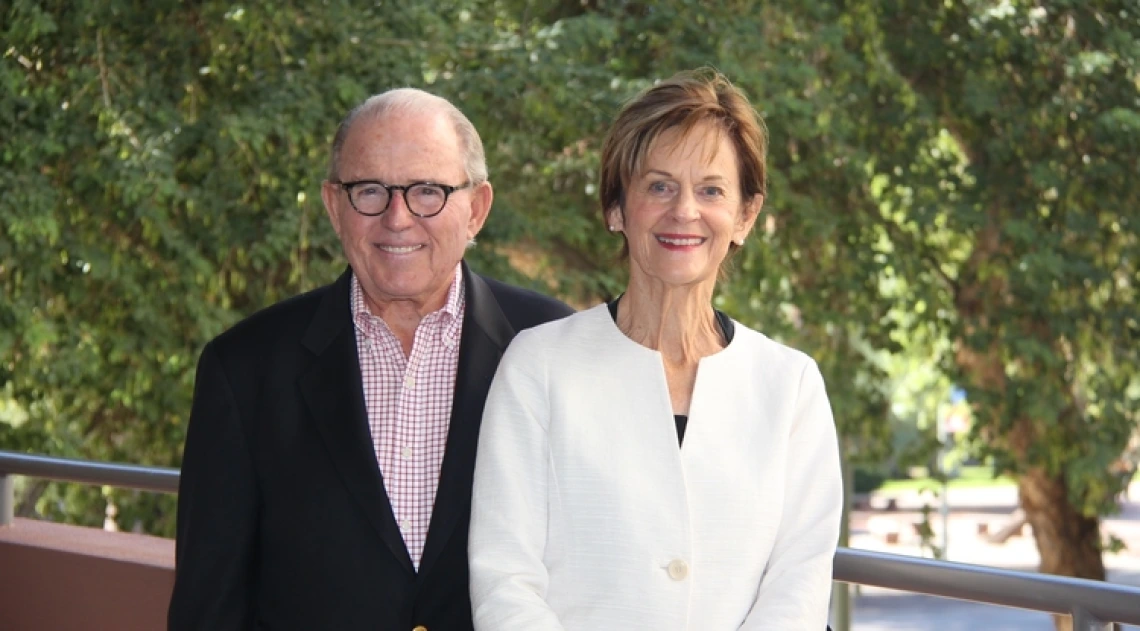$1.5M Gift to UA to Help Shape Biomedical Engineers of Tomorrow
The gift, from a UA alumnus and his wife, will help provide engineering students with hands-on experience in biomedical device fabrication.

Peter and Nancy Salter
University of Arizona alumnus Peter Salter and his wife, Nancy Salter, have gifted $1.5 million to fund a new biomedical instrument design studio and corresponding course development at the College of Engineering.
"This is an area that is developing very quickly," Peter Salter said. "I want to see the University of Arizona be a leader in this area of medical device product development in regard to engineering."
When Peter graduated from the University of Arizona in 1965, it was with a history degree, though he took physics and mathematics courses as well. Shortly after graduation, he went to work for a company that developed medical devices.
"One thing led to another, and before long, I had my own medical device company," he said.
Salter founded his global medical device company, Salter Labs, in 1976, and today it is a leading global manufacturer of respiratory products for both hospitals and home care. For more than 40 years, the company's commitment to satisfying patients and clients has been rooted in focusing on how researchers can design and create better products.
"I think Peter's interest in research and development was what led to the success of our company," Nancy Salter said. "He was willing to commit himself to developing new products, and that led to a lot of growth."
Paying It Forward
The Salters' gift "is a significant contribution to a unique laboratory and course that will serve as an example in academia," said Larry Head, interim dean of the College of Engineering. "Not only will this laboratory play a role in advancing life-changing – and lifesaving – technology, but it will help prepare students to be future leaders in biomedical engineering."
By providing engineering students with hands-on experience in biomedical device fabrication, the Salters hope to instill the same interest and passion for constructing devices in areas such as biomechanics, electro-mechanics, flexible electronics, micro-fluidics, imaging, sensors and biomaterials. The lab will expose students to opportunities that are not part of most biomedical engineering programs.
"The Salters understand the importance of our students gaining hands-on, real-world design and build experience," said Jennifer Barton, professor of biomedical engineering and director of the BIO5 Institute, which harnesses the power of five core disciplines – agriculture, engineering, medicine, pharmacy and science – to find solutions to complex, biology-based challenges. "Biomedical instrumentation offers the opportunity for students to integrate engineering principles with biological knowledge and medical needs, and begin to understand the complexities associated with creating useful, effective and safe products that improve lives."
The UA Department of Biomedical Engineering, housed in the College of Engineering, will be the lead department for the new space, with associate professor Urs Utzinger and assistant professor Philipp Gutruf developing an accompanying course and program that will reach biomedical engineers, and interested engineers in other majors, throughout their undergraduate careers.
"Pete and Nancy have supported the UA in so many ways over the years," said John-Paul Roczniak, president and CEO of the University of Arizona Foundation. "They've always been champions for entrepreneurship and innovation, especially in health care, and so this gift is an especially meaningful legacy. It is going to create incredible opportunities for biomedical engineering students."
A Four-Year Design Program
Students in the College of Engineering design and test solar ovens during their freshman year, build "Skittle sorters" during their sophomore year and complete engineering design projects during their senior year. This course will bridge the gap between sophomore and senior year, making the Department of Biomedical Engineering the first department in the college to have a design project element during all four years of an undergraduate degree.
"This new course, in a well-equipped new facility, will allow us to complete our vision of a four-year design experience for all of our BME undergraduate students," said Art Gmitro, head of the department. "The BME faculty is excited about contributing ideas for learning modules that will highlight emerging technologies and innovative biomedical applications. I think the students will be even more excited when they see the what we have in store for them in this class."
This gift also aligns with the college's new emphasis on collaborative learning, allowing students to work together in a laboratory environment and learn by doing. The combination of this approach with the new resources made possible by the generosity of Peter and Nancy will leave students prepared for not only their senior design projects, but for their postgraduate studies or careers in engineering.
"This new design studio is going to be crucial not only for our engineering students' educational experience but for the innovative research at the UA that will benefit our society, and we are all incredibly grateful to Peter and Nancy for their transformational generosity," said UA President Robert C. Robbins. "With this gift, our engineering students will have cutting-edge, hands-on experience that will translate into new designs for lifesaving medical devices. As we begin to implement our new strategic plan, investments like this one from the Salters will help the UA tackle critical challenges and become a global leader in the Fourth Industrial Revolution."



